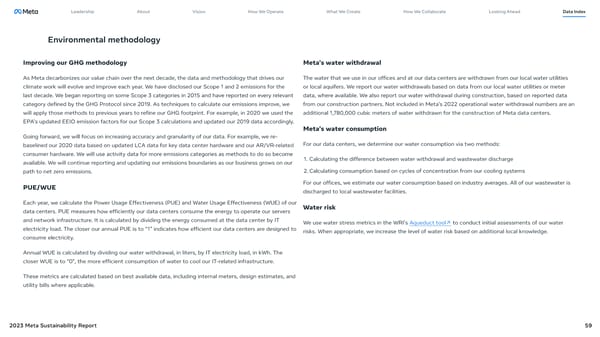Leadership About Vision How We Operate What We Create How We Collaborate Looking Ahead Data Index Environmental methodology Improving our GHG methodology Meta’s water withdrawal As Meta decarbonizes our value chain over the next decade, the data and methodology that drives our The water that we use in our offices and at our data centers are withdrawn from our local water utilities climate work will evolve and improve each year. We have disclosed our Scope 1 and 2 emissions for the or local aquifers. We report our water withdrawals based on data from our local water utilities or meter last decade. We began reporting on some Scope 3 categories in 2015 and have reported on every relevant data, where available. We also report our water withdrawal during construction, based on reported data category defined by the GHG Protocol since 2019. As techniques to calculate our emissions improve, we from our construction partners. Not included in Meta’s 2022 operational water withdrawal numbers are an will apply those methods to previous years to refine our GHG footprint. For example, in 2020 we used the additional 1,780,000 cubic meters of water withdrawn for the construction of Meta data centers. EPA’s updated EEIO emission factors for our Scope 3 calculations and updated our 2019 data accordingly. Meta’s water consumption Going forward, we will focus on increasing accuracy and granularity of our data. For example, we re- baselined our 2020 data based on updated LCA data for key data center hardware and our AR/VR-related For our data centers, we determine our water consumption via two methods: consumer hardware. We will use activity data for more emissions categories as methods to do so become 1. Calculating the difference between water withdrawal and wastewater discharge available. We will continue reporting and updating our emissions boundaries as our business grows on our path to net zero emissions. 2. Calculating consumption based on cycles of concentration from our cooling systems PUE/WUE For our offices, we estimate our water consumption based on industry averages. All of our wastewater is discharged to local wastewater facilities. Each year, we calculate the Power Usage Effectiveness (PUE) and Water Usage Effectiveness (WUE) of our Water risk data centers. PUE measures how efficiently our data centers consume the energy to operate our servers and network infrastructure. It is calculated by dividing the energy consumed at the data center by IT We use water stress metrics in the WRI’s Aqueduct tool↗ to conduct initial assessments of our water electricity load. The closer our annual PUE is to “1” indicates how efficient our data centers are designed to risks. When appropriate, we increase the level of water risk based on additional local knowledge. consume electricity. Annual WUE is calculated by dividing our water withdrawal, in liters, by IT electricity load, in kWh. The closer WUE is to “0”, the more efficient consumption of water to cool our IT-related infrastructure. These metrics are calculated based on best available data, including internal meters, design estimates, and utility bills where applicable. 2023 Meta Sustainability Report 59
 Meta 2023 Sustainability Report Page 58 Page 60
Meta 2023 Sustainability Report Page 58 Page 60